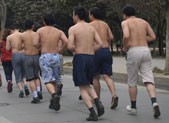
 |
| Dabaiyang Shehuo Photo: Courtesy of Wang Zhi (GT) |
'Shehuo' parades promote teamwork and put kids on a pedestal - literally
Perhaps you have seen parades that combine familiar Chinese folk performances like yangge dance, acrobatics, and dragon and lion dancing. But there is one traditional performance that even many Chinese may have never heard of where children are perched atop poles or stand on an adult performer's shoulder dressed like characters from Peking opera. It is called shehuo and also features adults standing on stilts or dancing with huge doll-like headpieces covering their heads.
Shehuo is a traditional Chinese folk art form often performed during the Chinese New Year. She means the god of land, and huo means fire, suggesting a flourishing and crowded scene. Shehuo performances used to be an act of worshiping the god of the land as well as a celebration of harvest. Gradually, it turned into a pure art and cultural event without the religious aspect.
Various forms and stories
A big day for shehuo performances is for the Lantern Festival, the 15th day after Chinese New Year's Eve. The crowd will light firecrackers to welcome the parade, and some performers will throw small gifts to the children. Such big events are common in North and Northwest China, but mostly in the countryside.
Shaanxi, Shanxi and Henan provinces all have shehuo performances with their own distinct characteristics. Di (ground) shehuo, for example, usually features clowns and comic elements along with martial arts body movements. Ma (horse) shehuo is performed with actors riding on horses or donkeys. Further distinctions have evolved within each province or county, and the scale of the event also varies from less than 100 people to thousands of performers.
Similar to Chinese operas, shehuo has a number of classical performances like The Tale of the White Snake, and Judge Bao and The Qin Xianglian Case. However, there is one particular type called xue (blood) shehuo, with its story taken from the Chinese literary classic Water Margin in which Wu Song, a person with martial art skills, kills the person who murdered his brother. According to Song Zhirong, a shehuo artist who has performed for over 40 years, the violence in xue shehuo is too graphic (depicting mortal head wounds) and not in keeping with an auspicious New Year, thus it is no longer a usual part of shehuo performances.

















 Employees run half-naked for not meeting sales quotas
Employees run half-naked for not meeting sales quotas


![]()
